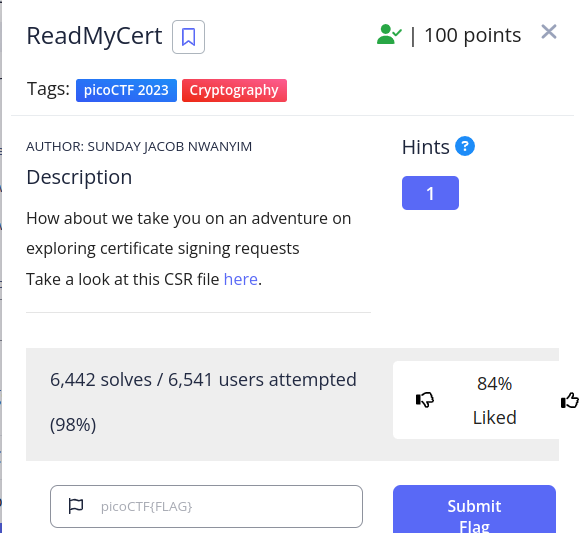Pico CTF (ReadMyCert)
Pico CTF (ReadMyCert)
ReadMyCert
AUTHOR: SUNDAY JACOB NWANYIM
Description How about we take you on an adventure on exploring certificate signing requests Take a look at this CSR file here
Solution
In this challenge, we shall learn how to read CSR(certificate signing requests) using openssl OpenSSL is a widely-used cryptographic library that includes a command-line tool for working with CSRs. Let’s solve this challenge, shall we?
- Download the given
readmycert.csr. - Use the
fileto read the certificates properties.
- Let’s view the contents of the certificate by running
cat readmycert.csr
- Now, lets get all details of the CSR using the command
openssl req -in readmycert.csr -noout -textwhich will display the CSR details, including the subject, organization, common name, and other relevant information. - Lets understand the commands in details.
- Flag/Option:
openssl - This is the command-line tool used to perform various cryptographic operations using the OpenSSL library.
- Flag/Option:
- Flag/Option:
req - It is a subcommand of OpenSSL specifically used for working with certificate requests, including CSRs.
- Flag/Option:
- Flag/Option:
-in your_csr_file.csr - This flag specifies the input file for the CSR. Replace your_csr_file.csr with the actual path and filename of your CSR file.
- Flag/Option:
- Flag/Option:
-noout - This flag instructs OpenSSL not to output the actual certificate but only display the CSR’s text representation. It prevents generating any output other than the textual information.
- Flag/Option:
- Flag/Option:
-text - This flag tells OpenSSL to display the CSR details in a human-readable format. It provides a comprehensive view of the CSR’s contents, including the subject’s distinguished name (DN), public key information, and any other attributes included in the request.
- Flag/Option:
- We get our flag in the subject of the certificate.
 That is it, I hope you learnt a thing or two from this challenge.
That is it, I hope you learnt a thing or two from this challenge.
This post is licensed under CC BY 4.0 by the author.
